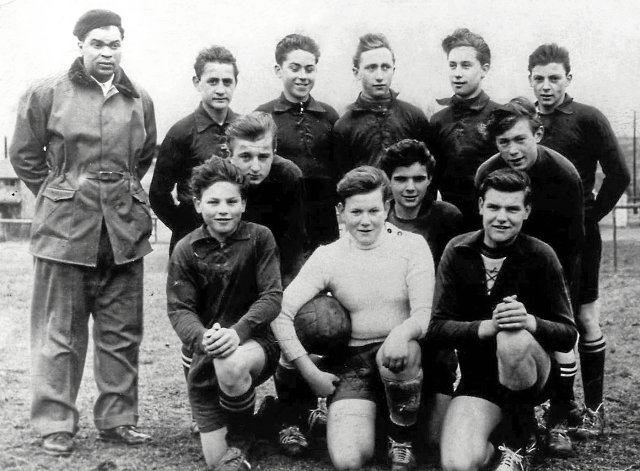Heinz Kerz (l.) as a football coach in Nieder-Olm in the early 1950s
Photo: Nieder-Olm City Archives
Nieder-Olm is a community with almost 10,000 inhabitants near Mainz. In the Old Town Hall, the former city archivist Anuschka Weisener has laid out historical photos on a table. In one picture, six young people are standing at the edge of a swimming pool and smiling. In another, young footballers look confidently into the camera. The first motif comes from the early 30s, the second probably from the early 50s. Seen on both: the black footballer, coach and swimming instructor Heinz Kerz. “It is remarkable that Heinz Kerz returned to Nieder-Olm after the war,” says Weisener. »Even though they wanted to destroy him. He came back and obviously lived a full life.”
A black footballer persecuted by the Nazis? Little is known about this in the historiography of sport. For a better understanding, one should tell the story from the beginning, where racism goes hand in hand with anti-Semitism.
After the First World War, the victorious powers occupied large parts of the Rhineland; among them are French soldiers who come from African colonies. In the German Reich, politicians are outraged against this “black disgrace.” A satirical magazine shows a gorilla wearing a French military cap carrying a white statue of a woman. In “Mein Kampf” Hitler writes that the stationing of black soldiers is a strategy of the “Jews” to use the “inevitable bastardization” to destroy the white race they hate, to fall from their cultural and political heights and to become their masters themselves «.
Many of the more than 500 children fathered by French soldiers and German women experience racism at an early age. They are vilified as “Rhineland bastards.” One of them: Heinz Kerz, born in 1920. But the striker earned a good reputation in football in Nieder-Olm. “He was called the Black Bomber. Many people in the community looked at Heinz Kerz with appreciation,” says Markwart Herzog, director of the Swabian Academy in Irsee, Bavaria. The philosopher, sports and cultural historian has been researching historical topics in football for many years and came across files on Kerz in the Speyer State Archives.
After the National Socialists came to power, Kerz was expelled from the football club in Nieder-Olm. At the age of 18, he was taken to a hospital in Darmstadt and forcibly sterilized. More than 400 black people had to endure this procedure following a “Fihrer’s order”. Kerz was later arrested without charge and interned in the Dachau concentration camp for two years, reports Herzog. Kerz had to do forced labor and was sent on one of the “death marches” in 1945. 2,000 people of African descent are murdered in the concentration camps, but Kerz survives.
After the war, Kerz built a new life in Nieder-Olm, reports former city archivist Anuschka Weisener: “He apparently looked without resentment at those who had once humiliated and driven him away.” Many perpetrators still live in Nieder-Olm, but Kerz is looking ahead. He is involved as a coach in the football club and teaches children to swim. He sits on the local council for the SPD and looks forward to the carnival every year. A photo shows him swaying with a former SA man. Herzog concludes: “He obviously wanted to belong again to the community to which he had belonged for so long.”
There are whispers in town about Kerz and his childless marriage, but he doesn’t want to talk publicly about the forced sterilization. Anuschka Weisener points to another photo from 1980. You can see Heinz Kerz, now 60, being sent off into early retirement by the mayor. He has been suffering from heart problems since being imprisoned in a concentration camp, but in the picture he appears satisfied and proudly presents his certificate of honor. Only six months later he died of a heart attack.
In Germany there is currently intensive discussion about the influence of right-wing extremists, including racism in society. Nevertheless, historical knowledge is often lacking: Only a few people are aware that black people have been living in German-speaking countries for a long time, for more than 400 years. The Ghanaian philosopher Anton Wilhelm Amo taught at the universities in Halle (Saale), Wittenberg and Jena in the 18th century. During colonialism on the threshold of the 20th century, several hundred Africans from the “protected areas” lived in the German Empire. As a rule, they were not entitled to full civil rights; They were denied social security or unemployment benefits. For a long time, sources about their biographies were not archived or intentionally destroyed. And the work of remembrance in football has been neglected for a long time.
In the case of Kerz, more than 20 years passed after his death before the people of Nieder-Olm remembered their popular football coach again. A sports hall now bears his name. And students often discuss him in history class. On Holocaust Remembrance Day 2023, archivist Weisener will give a lecture about Kerz. The crowd is so large that she has to move the event to a larger hall. Weisener works as a sports trainer herself. She would think it would be great if Kerz would also become a role model in other clubs.
Ronny Blaschke’s book about racism and colonialism in football: “Playground of the Master Men”Die Workshop publishing house, 256 pages, €22.
#ndstays – Get active and order a promotional package

Regardless of whether it is pubs, cafés, festivals or other meeting places – we want to become more visible and reach everyone who values independent journalism with an attitude. We have put together a campaign package with stickers, flyers, posters and buttons that you can use to get active and support your newspaper.
To the promotional package
sbobet88 sbobet sbobet88 sbobet88
